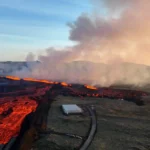Vesuvianite, also known as Idocrase, is a captivating gemstone prized for its vibrant colors and intriguing properties. From its volcanic origins to its potential metaphysical benefits, this comprehensive guide explores everything you need to know about Vesuvianite.
Unveiling the Allure of Vesuvianite
Vesuvianite, sometimes called Idocrase, gets its name from Mount Vesuvius, where it was first discovered. This calcium aluminum sorosilicate forms in skarn deposits, geological environments created by contact metamorphism. Essentially, magma’s intense heat and pressure transform surrounding rocks, giving birth to Vesuvianite. While initially found in Italy, Vesuvianite deposits exist globally, from Canada and Russia to Pakistan and the United States.
Exploring Vesuvianite’s Characteristics
Vesuvianite’s appearance varies depending on the minerals present during its formation. Its luster can be vitreous (glassy) or resinous, and its transparency ranges from translucent to transparent. With a Mohs hardness of 6.5, it’s relatively durable but still requires care. Its specific gravity, between 3.32 and 3.47, indicates it’s about three times heavier than water. Vesuvianite lacks distinct cleavage, and its fracture is typically uneven or subconchoidal. It occurs in a stunning array of colors, from olive green and brown to vibrant blue, yellow, and even purple. Some specimens exhibit pleochroism, appearing to change color in different lighting, while others may fluoresce under UV light.
Delving into Vesuvianite’s Metaphysical Properties
While scientific research on Vesuvianite’s metaphysical properties is limited, many believe it possesses unique energies. Some associate it with emotional healing, suggesting it may help release negativity and foster inner peace. Others believe it can enhance spiritual growth, deepen connection with nature, and aid personal transformation. Some proponents suggest it may support physical health by aiding detoxification and boosting the immune system. In some traditions, Vesuvianite is linked to the heart and root chakras, associated with love, compassion, grounding, and security. Want to learn more about what troches are? You can find out more here. If you would like more information about what caused Sean’s brain injury, you can find out more here.
Understanding Vesuvianite’s Practical Applications
Vesuvianite’s beauty and durability make it a versatile gemstone. It’s a popular choice for jewelry, adorning rings, pendants, and earrings. Artisans carve it into ornamental objects, showcasing its unique crystal forms and captivating hues. It’s also highly valued by mineral collectors, each piece a testament to its geological journey. Prices for Vesuvianite vary widely, from a few pounds for tumbled stones to over a thousand pounds for large, high-quality faceted gems or rare collector’s specimens.
Caring for Your Vesuvianite
Caring for Vesuvianite is straightforward. Warm, soapy water and a soft brush are usually sufficient for cleaning. Avoid harsh chemicals and ultrasonic cleaners, which can damage the stone. Store Vesuvianite separately from other gemstones to prevent scratches, ideally in a soft pouch or lined jewelry box.
Harnessing Vesuvianite’s Potential Benefits
Vesuvianite is believed to offer a range of potential benefits, encompassing emotional, spiritual, and physical well-being. It may help reduce anxiety and promote emotional stability, potentially assisting in overcoming negative thought patterns and fostering self-confidence. Some believe it enhances intuition, deepens meditation, and facilitates spiritual connection and self-discovery. While not scientifically proven, some suggest it may support digestion and detoxification. It’s also thought to potentially spark creativity and enhance artistic expression. Remember, these effects are often subjective and based on personal experience. While scientific research is limited, anecdotal evidence and historical use are compelling.
Exploring Vesuvianite’s Spiritual Significance
Vesuvianite is often seen as a tool for spiritual exploration and personal growth. Many believe it can enhance intuition and facilitate a deeper understanding of oneself and the world. It’s sometimes used in meditation to deepen focus and enhance spiritual understanding. Some associate Vesuvianite with releasing pent-up anger and resentment, promoting emotional healing and a sense of peace. It’s often linked to the heart and solar plexus chakras, potentially influencing love, compassion, personal power, and self-confidence. Different colors of Vesuvianite are sometimes associated with different chakras, suggesting further exploration.
Decoding Vesuvianite’s Rarity
Vesuvianite’s rarity depends on several factors. Raw Vesuvianite is relatively common, but gem-quality specimens, especially those with vibrant colors, are considerably rarer and more valuable. Color significantly impacts rarity and value. While green and brown varieties are common, rarer hues like pink, purple, and vivid blue are highly prized. The source also matters; certain locations are known for producing higher-quality Vesuvianite. Faceted, transparent Vesuvianite is the rarest and most valuable, particularly in larger sizes and intense colors.
| Property | Description |
|---|---|
| Name | Vesuvianite (also known as Idocrase) |
| Chemical Formula | Ca19(Al,Mg,Fe)13(SiO4)10(Si2O7)4(OH,F,O)10 |
| Hardness | 6.5 on the Mohs Scale |
| Luster | Vitreous to Resinous |
| Transparency | Translucent to Transparent |
| Specific Gravity | 3.32 – 3.47 |
| Cleavage | Indistinct |
| Fracture | Uneven to Subconchoidal |
| Colors | Olive green, brown, blue, yellow, purple, red, colorless, white, black |
| Forms | Pyramidal crystals, massive, granular |
| Fluorescence | Possible in some specimens |
| Sources | US, Italy, Switzerland, Austria, Canada, Kenya, Tanzania, Russia, Pakistan |
Disclaimer: This information is for informational purposes only and does not constitute medical or professional advice. The metaphysical properties described are based on traditional beliefs and are not scientifically proven. Consult a qualified healthcare professional before using crystals or gemstones for healing purposes.
- Revolution Space: Disruptive Ion Propulsion Transforming Satellites - April 24, 2025
- Race Through Space: Fun Family Game for Kids - April 24, 2025
- Unlocking the Universe: reading about stars 6th grade Guide - April 24, 2025
















